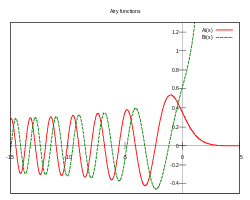Sturm separation theorem
In mathematics, in the field of ordinary differential equations, Sturm separation theorem, named after Jacques Charles François Sturm, describes the location of roots of solutions of homogeneous second order linear differential equations. Basically the theorem states that given two linear independent solutions of such an equation the zeros of the two solutions are alternating.

Sturm separation theorem
Given a homogeneous second order linear differential equation and two continuous linear independent solutions u(x) and v(x) with x0 and x1 successive roots of u(x), then v(x) has exactly one root in the open interval (x0, x1). It is a special case of the Sturm-Picone comparison theorem.
Proof
Since and are linearly independent it follows that the Wronskian must satisfy for all where the differential equation is defined, say . Without loss of generality, suppose that . Then
So at
and either and are both positive or both negative. Without loss of generality, suppose that they are both positive. Now, at
and since and are successive zeros of it causes . Thus, to keep we must have . We see this by observing that if then would be increasing (away from the -axis), which would never lead to a zero at . So for a zero to occur at at most (i.e., and it turns out, by our result from the Wronskian that ). So somewhere in the interval the sign of changed. By the Intermediate Value Theorem there exists such that .
On the other hand, there can be only one zero in , because otherwise v would have two zeros and there would be no zeros of u in between, and it was just proved that this is impossible.
References
- Teschl, G. (2012). Ordinary Differential Equations and Dynamical Systems. Providence: American Mathematical Society. ISBN 978-0-8218-8328-0.